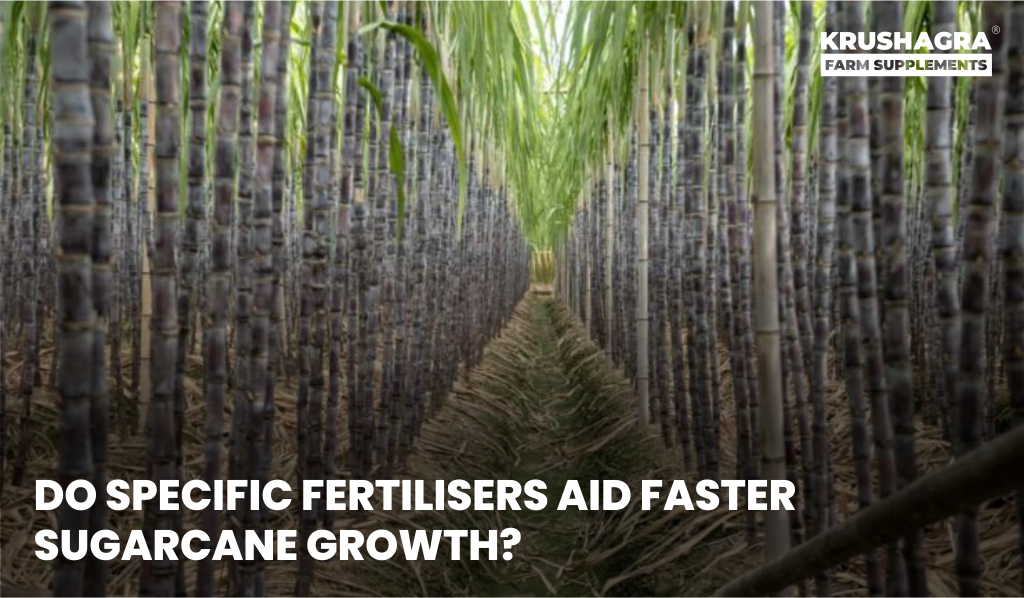Sugarcane is a crucial crop for many economies, especially in tropical and subtropical regions, as it serves as the primary source of sugar, ethanol, and various by-products. Its cultivation demands a precise balance of nutrients, proper soil conditions, and efficient management practices.
One critical aspect of maximising sugarcane growth and yield is using the right fertilisers. But are there specific fertilisers that can accelerate its growth? Let’s explore the science, techniques, and expert recommendations surrounding sugarcane fertilisation.
The Nutritional Needs of Sugarcane
To understand how fertilisers can boost sugarcane growth, it’s essential to recognize the crop’s nutritional needs. Sugarcane requires three primary macronutrients in significant amounts:
- Nitrogen (N): A vital nutrient for vegetative growth, nitrogen promotes the development of leaves and stems. It is essential during the initial stages of sugarcane growth.
- Phosphorus (P): This element is crucial for root development and energy transfer within the plant.
- Potassium (K): Potassium supports stalk strength, sugar content, and resistance to pests and diseases.
In addition to these, sugarcane also benefits from secondary macronutrients like calcium, magnesium, and sulphur, as well as micronutrients such as zinc, copper, and boron.
Fertilizer Options for Faster Sugarcane Growth
The choice of fertilisers for sugarcane depends on factors like soil type, climate, and growth stage. Below are some of the most effective fertilisers and strategies for faster growth:
1. Nitrogen-Based fertilisers
Nitrogen is often the first nutrient to be depleted in soils where sugarcane is cultivated. To ensure rapid growth:
- Urea: One of the most common nitrogen fertilisers, urea is water-soluble and promotes quick absorption.
- Ammonium Nitrate: Offers a fast-acting nitrogen source, essential for early-stage growth.
- Green Manures: Organic sources like legumes enrich the soil with nitrogen naturally.
2. Phosphorus-Enriched fertilisers
Phosphorus is particularly important during the germination and early growth stages:
- Single Super Phosphate (SSP): Contains both phosphorus and sulphur, enhancing root growth.
- Diammonium Phosphate (DAP): A balanced option providing nitrogen and phosphorus.
3. Potassium Supplements
Potassium contributes significantly to sugarcane’s quality and resilience:
- Muriate of Potash (MOP): Widely used to meet the potassium needs of sugarcane.
- Sulphate of Potash (SOP): A premium option with low chloride levels, suitable for sugarcane’s salt-sensitive varieties.
4. Micronutrient-Rich fertilisers
Adding micronutrients in chelated form ensures availability to plants:
- Zinc sulphate, copper sulphate, and borax are common supplements to address deficiencies.
5. Bio-fertilisers
Eco-friendly and cost-effective, bio-fertilisers enhance soil fertility:
- Azotobacter and Azospirillum: Nitrogen-fixing bacteria improve soil nitrogen levels.
- Phosphate-Solubilizing Bacteria (PSB): Help make phosphorus available for plant uptake.
Fertiliser Application Techniques for Optimal Growth
The method and timing of fertiliser application significantly impact sugarcane growth. Here are some best practices:
1. Soil Testing and Analysis
Conducting a soil test before planting helps identify nutrient deficiencies and determine the correct fertiliser dosage.
2. Split Application
Instead of applying fertilisers in one go, splitting the doses ensures steady nutrient availability throughout the crop’s lifecycle. For example:
- Apply nitrogen in three stages: during planting, after germination, and during the active growth phase.
3. Foliar Sprays
For micronutrient deficiencies, foliar sprays provide quick absorption. These are especially useful during the mid-growth stage.
4. Drip Fertigation
Combining irrigation with fertiliser application ensures uniform distribution and minimises wastage. It’s particularly effective for water-soluble fertilisers like urea.
The Role of Biofertilizers in Sugarcane Growth
Biofertilisers play a vital role in sugarcane cultivation by improving soil health, enhancing nutrient availability, and promoting sustainable farming practices.
Unlike synthetic fertilisers, organic options such as compost, farmyard manure, and press mud (a sugarcane by-product) enrich the soil with essential nutrients while improving its physical structure and water-holding capacity.
One significant advantage of biofertilisers is their ability to enhance microbial activity in the soil. Beneficial microorganisms help decompose organic matter, releasing nutrients in a slow, steady manner that aligns with sugarcane’s growth cycle.
This minimises nutrient leaching and reduces the environmental impact of fertilisation. Additionally, organic inputs increase the levels of humus, a key component that fosters root development and boosts plant resilience to pests and diseases.
Press mud, a popular organic option in sugarcane-growing regions, contains a rich mix of nitrogen, phosphorus, calcium, and micronutrients.
Its application not only supplies vital nutrients but also recycles industry by-products, promoting sustainability.
When used alongside synthetic fertilisers, biofertilisers create a synergistic effect, ensuring balanced nutrition and long-term soil fertility.
For farmers aiming for high yields and environmentally friendly practices, integrating organic fertilisers into their sugarcane management plan is both a practical and responsible choice.
Factors That Influence Fertiliser Effectiveness
The effectiveness of fertilisers for sugarcane depends on several factors:
- Soil pH: Sugarcane thrives in soils with a pH range of 5.0 to 8.5. Extremely acidic or alkaline soils can hinder nutrient uptake.
- Climate: Warm temperatures and adequate rainfall or irrigation are essential for sugarcane growth.
- Crop Variety: High-yielding sugarcane varieties may require customised fertilisation plans.
- Pest and Disease Management: Proper fertilisation strengthens sugarcane’s natural defences against pests and diseases.
- Environmental Considerations: While fertilisers enhance sugarcane growth, excessive or improper use can lead to environmental issues like soil degradation, water pollution, and greenhouse gas emissions. Adopting precision agriculture practices and using slow-release fertilisers can mitigate these impacts.
To Conclude
Yes, there are specific fertilisers and strategies to accelerate sugarcane growth. A balanced mix of nitrogen, phosphorus, potassium, and micronutrients, combined with advanced techniques like soil testing, split application, and bio-fertilisers, ensures optimal growth and yield.
However, sustainable practices and environmental responsibility should always be a priority.
By tailoring fertilisation to the unique needs of your soil, climate, and crop variety, you can maximise sugarcane productivity while safeguarding the environment.
Whether you’re a commercial farmer or a researcher, investing in proper fertilisation is key to unlocking sugarcane’s full potential.
Frequently Asked Questions
Which fertiliser is best for sugarcane?
A balanced combination of nitrogen, phosphorus, and potassium fertilisers, such as urea, diammonium phosphate (DAP), and muriate of potash (MOP), is best for sugarcane. The specific choice depends on soil conditions and the crop’s growth stage.
Can organic fertilisers be used for sugarcane?
Yes, organic fertilisers like compost, farmyard manure, and press mud are excellent for improving soil health, boosting microbial activity, and complementing synthetic fertilisers.
How often should fertiliser be applied to sugarcane?
Fertilisers are typically applied in split doses: during planting, after germination, and during the active growth stage. Foliar sprays or fertigation can be used mid-growth for additional nutrients.
What are bio-fertilisers, and how do they help sugarcane?
Bio-fertilisers like Azospirillum, Azotobacter, and phosphate-solubilizing bacteria improve soil fertility by fixing nitrogen and making phosphorus more available, promoting sustainable growth.
Does sugarcane require micronutrients?
Yes, sugarcane needs micronutrients like zinc, boron, and copper in small amounts. These can be supplied through chelated fertilisers or foliar sprays to correct deficiencies.





